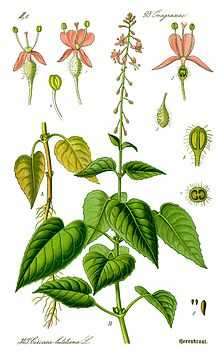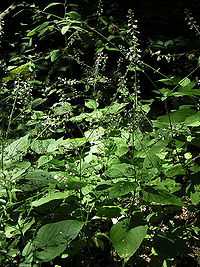Circaea lutetiana
| Enchanter's nightshade | |
|---|---|
 | |
| Enchanter's Nightshade Flora von Deutschland, Österreich und der Schweiz 1885 | |
| Scientific classification | |
| Kingdom: | Plantae |
| (unranked): | Angiosperms |
| (unranked): | Eudicots |
| (unranked): | Rosids |
| Order: | Myrtales |
| Family: | Onagraceae |
| Genus: | Circaea |
| Species: | C. lutetiana |
| Binomial name | |
| Circaea lutetiana L. | |
Circaea lutetiana, known as enchanter's-nightshade,[1] is a plant in the evening primrose family, Onagraceae.
The genus name comes from the enchantress Circe of Greek mythology and the generic designation is derived from Lutetia, the Latin name for Paris. Paris at one time was known as the "Witch City". Despite its name it is not especially toxic, but contains a lot of the astringent tannin.[2]
Description

Circaea lutetiana is a perennial herbaceous plant with opposite, simple leaves, on slender, green stems. The flowers are white, borne in summer. It grows 20 cm to 60 cm, rarely up to 75 centimeters high.[3]
The leaves are rounded or slightly notched at the base, they narrow gradually to the pointed tip and are not strongly toothed, but have sinuate edges. The leaf stalks are equally hairy all round.[4]
The flower has 2 notched petals, 2 stamens and a 2-lobed stigma. The open flowers are well spaced along the stalk and there are no bracts at base of individual flower stalks. The fruit consists of 2 equal cells, and usually sets seed. The flower stalks become angled downwards before fruiting.[5]
In winter the aerial parts die off leaving an underground rhizome.
Distribution
The plant is native to Europe, Middle Asia and Siberia. They grow in woods in deep shade and moist environments on nitrogen-containing clay.
Gardening
It is only rarely used as a garden plant, one variety is known as 'Caveat Emptor', has leaves that are heavily mottled pink.
Uses
Circaea lutetiana herb has been used in the traditional Austrian medicine internally as tea, or externally as cold maceration in ethanol, for treatment of rheumatism, gout, infections, and fever.[6]
References
- ↑ "BSBI List 2007" (xls). Botanical Society of Britain and Ireland. Retrieved 2014-10-17.
- ↑ Alchemy Works Accessed April 2014
- ↑ Natural England. Accessed July 2011
- ↑ English Country Garden Accessed July 2011
- ↑ Plant Identification UK Accessed July 2011
- ↑ Vogl, S; Picker, P; Mihaly-Bison, J; Fakhrudin, N; Atanasov, A. G.; Heiss, E. H.; Wawrosch, C; Reznicek, G; Dirsch, V. M.; Saukel, J; Kopp, B (2013). "Ethnopharmacological in vitro studies on Austria's folk medicine--an unexplored lore in vitro anti-inflammatory activities of 71 Austrian traditional herbal drugs". Journal of Ethnopharmacology 149 (3): 750–71. doi:10.1016/j.jep.2013.06.007. PMC 3791396. PMID 23770053.